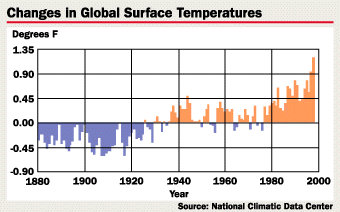Global
Change Scenario
Below is a January 12, 1999 Associated Press article "Researchers:1998
was hottest year on record"
| WASHINGTON
(AP) -- The world’s temperature bumped up a
notch last year, rising 0.34 degrees Fahrenheit to make
1998 the warmest year on record.
"It
is really quite extraordinary. We’ve got
a record and it’s one of the largest increases
that we’ve ever seen in one year, " said D.
James Baker, head of the National Oceanic and Atmospheric
Administration.
In
recent years rising temperatures caused by human industrial
activity have raised concerns that the planet would
dangerously overheat. That led to the controversial
agreement reached in Kyoto, Japan, in December 1997
seeking to reduce emissions of carbon dioxide and other
gases thought to threaten the climate.
Other
scientists, however, contend that the temperature changes
could be the result of normal climate fluctuations and
say that, at any rate, some warming might do more good
than ill.
"One
has to say we’re seeing a combination of natural
phenomena and a very strong indication of human effects
here, we’re starting to get out of the range of
normal climatic variability," Baker said.
"We’ve got 20 years in a row with annual global
surface temperatures above the long-term average."
|
The
NASA scientists, using NOAA and other data, calculated
an average 1998 worldwide temperature of about 58.496
degrees F., topping the record, set in 1995 of 58.154.
In
its separate calculations, NOAA’s National Climate
Data Center said 1998’s global average was 58.1
degrees, topping 1997, which is calculated as the previous
record year. NOAA readings for earlier years were
not immediately available because of a change in its
record keeping, however.
But
both NOAA and NASA agreed that 1998 is the new record
year.
And
the warming is beginning to hit home, NASA said.
The United States last year experienced its warmest
year in the past several decades.
Scientists
James Hansen, Reto Ruedy, Jay Glascoe and Makiko
Sato of the National Aeronautic and Space Administration’s
Goddard Institute for Space Studies based their findings
on data collected from thousands of meteorological stations
by NOAA. They also used satellite measurements
of ocean temperature to obtain a second measure of global
temperature change that is more uniformly spaced over
the world.
The
exact results will probably change slightly as late-reporting
station data are included, but late data will not alter
the conclusion that 1998 easily set records, the agency
said.
|
Steadily
rising global temperatures during the past century, which
helped make 1998 the warmest year in the more than 100 years
that records have been kept, have convinced many climatologists
that global warming is real and that global climate change
will continue well into the next century.

Situation
Science does not possess the conclusive
evidence that global warming has occurred. But the absence
of definitive scientific evidence does not diminish the possibility. What
we know is that humankind has altered the ecology of the planet.
We know that millions of acres of forests were lost last
year. We know that air quality has deteriorated across the
globe as industrialization and urbanization combine to pollute
the atmosphere and deplete the ozone layer. We know that deserts
have expanded and that populations are suffering the loss
of arable lands. We know that elevated sea surface temperatures
can cause damage to coral reefs.
NASA's
Earth Science Enterprise (ESE) has approached your team of
Earth Systems scientists for a thorough evaluation of all
the factors related to global climate change. Should
the global climate actually be changing,
ESE
would like for you to examine the effects of global
warming, identify the suspected causes of global warming,
and using your analysis, provide suggestions to minimize these
causes and effects.
Assignments
Over the next two weeks (Week A and Week B) you will work
individually and in teams to address the global change situation.
Use the links below to access your assignments.
Week A: Teacher
as Problem Solver
Private
Theory Activity and Rubric
Individually,
identify what you believe to be true and the reasons for why
you have those beliefs regarding global change.
Week A: Teacher
as Problem Solver
Knowledge-Building
Activity and Rubric
As
a team, build ESS knowledge about the global change event
described in the scenario, and develop a problem statement.
Week B: Teacher
as Model Builder
Model-Building
Activity and Rubric
Using
your team's original or revised problem statement, build an
ESS model that includes the ESS relationship statements and
evidence that support your conclusions (recommendations or solutions).
[
Home ] [ Intro
] [ Guide ] Outline [ Classroom
]
HTML code
by Chris Kreger
Maintained by ESSC Team
Last updated July 25, 2000
Privacy
Statement and Copyright©
1997-2000 by Wheeling Jesuit University/NASA Classroom of the Future™. All
rights reserved.
|

